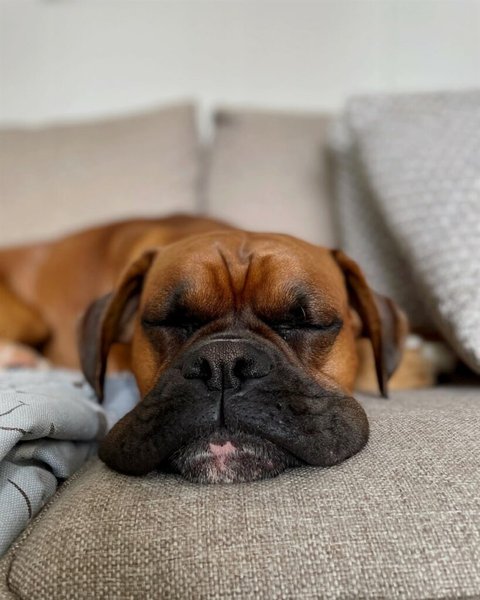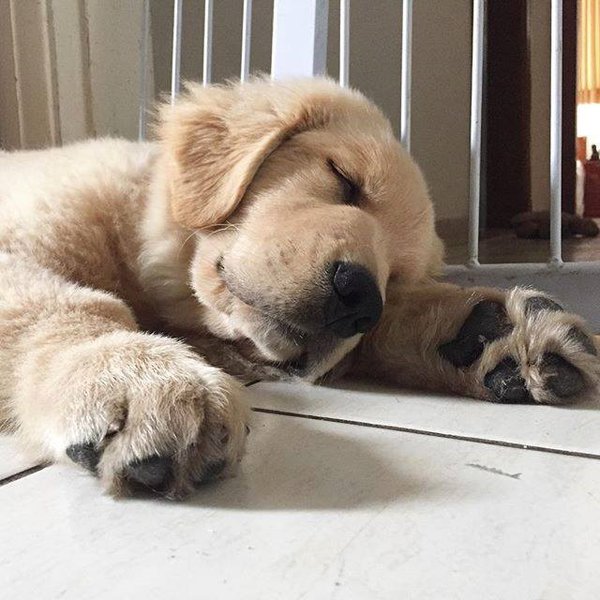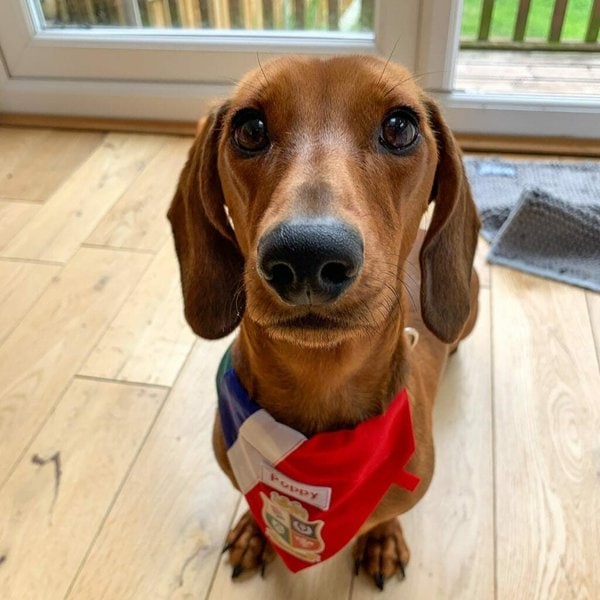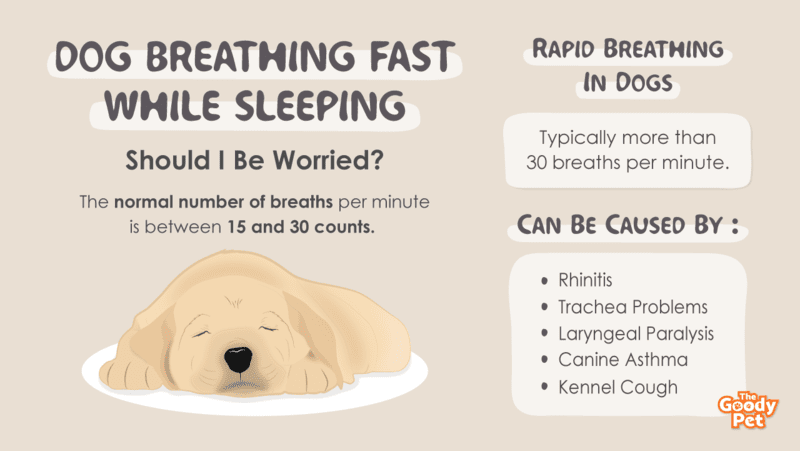We know that it can be pretty scary to see your dog breathing fast while sleeping, more so if it comes close to panting. What’s more bothersome is if you are not sure whether this is normal or if it is a health problem.
In general, there is nothing to be alarmed about the dog breathing fast while sleeping. It is most likely caused by an exciting dream or a physical characteristic relevant only to specific dog breeds. Unfortunately, there are other reasons why your dog is breathing fast while asleep, like the health complications of Kennel Cough.
To learn more about the concern of dogs breathing fast while sleeping, we’ll share with you useful information about the normal and medical reasons why a dog’s breathing increases at rest and what home remedies you can do to calm down its fast breathing. We’d also let you know how to count the normal breaths per minute of a healthy dog.
Is It Normal For Dogs To Breathe Fast When They Sleep?
Yes, it is normal for dogs to breathe fast while sleeping. For most dogs, the normal number of breaths per minute is between 15 and 30 counts. Anything lower than this range is still considered normal for as long as your pooch is healthy and active.
How to count: number of breaths in 30 seconds x 2 = # breaths per minute
After you’ve counted and the result is normal, the non-medical issues that you shouldn’t be worried about are having vivid dreams and the age of your dog. Also, brachycephalic dog breeds, like a Pug, tend to breathe fast while asleep.

Vivid Dreams
Just like you and other mammals, your pooch also enters the dream state during deep sleep. This phase is rapid eye movement or REM, where it is normal for the breathing to get faster.
During REM, the mental processes or the brainwaves of your dog get faster and irregular while the muscles are in a relaxed state. During this phase of heightened mental activity, it is normal for your dog’s breathing patterns to increase.
In fact, both man and man’s best friend have similar brain wave patterns of the sleep cycle, making it safe to conclude that it is normal for dogs to dream (either good or bad) as their human parents do.
Along with rapid breathing, you may also observe your dog’s muscles and eyelids begin to twitch. Plus, you may even hear some little and light barks and whimpers, almost similar to a person talking during REM.
Age Of Your Dog
Did you know that a puppy’s respiratory and heart rates are faster than adult dogs? This is also true during sleep. This is because a puppy’s body is still in the developmental stage. But, as soon as it grows into adulthood, this issue will resolve on its own.
Stress is another reason why your puppy is breathing faster while sleeping. It is natural for a puppy to feel stressed or even scared during its first few days in your home.
After all, it just left its mom and its littermates. It has a new world to explore, new people, and perhaps other animals to meet. These can be overwhelming experiences causing your new baby a tremendous amount of stress that results in rapid breathing even while sleeping.
Brachycephalic Dog Breed
If you have a dog with a smashed-face appearance, like a Shih Tzu, it is common to see it breathe faster during sleep. This is because of the narrow nostrils of brachycephalic dogs that make breathing more complicated. That said, it is not unusual to see brachycephalic dogs pant even while at rest.
Also, smaller dogs that weigh less than 30 lbs have a faster heart rate which results in faster breathing.
What Does Rapid Breathing In Dogs Mean?
Rapid breathing, typically more than 30 breaths per minute, can be caused by any of these health problems: Rhinitis, Trachea (Windpipe) Problems, Laryngeal Paralysis, Asthma, and Kennel Cough.
Along with rapid breathing, if you see any signs of breathing difficulty listed below, have your dog examined by a veterinarian.
The Signs Of Breathing Difficulty
- You will see your dog drooling more frequently than it usually does and appears like it is choking.
- You hear a raspy, snorting, or congested breathing.
- Open mouth breathing or heavy panting under cool or normal temperature or have not exercised.
- The abdominal area heaves faster with every breath.
- The gum and tongue color are grayish or bluish instead of a pinkish tinge.

Rhinitis
This respiratory condition may not be life-threatening, but it causes a great amount of discomfort to your pooch. Inflammation in the mucus membrane in the nasal area brings about symptoms such as nasal discharge, sneezing, rapid breathing, and difficulty in breathing.
Causes of canine rhinitis are varied and can be fungal or bacterial infections, seasonal allergies, and cancers.
Trachea (Windpipe) Problems
A congenital disorder wherein the trachea collapses as a result of not having enough sturdy c-shaped cartilage rings. The most common signs are dry cough and labored breathing.
Small dog breeds that tend to suffer from trachea problems are Pomeranians, Toy and Miniature Poodles, Pugs, Chihuahuas, and Yorkshire Terriers.
Laryngeal Paralysis
When the larynx does not completely open, it limits the entry of air into the lungs resulting in laryngeal paralysis.
To tell if your pooch has this condition, what you hear is honking goose-like sounds with each breath drawn. This condition makes it difficult for your pooch to breathe well, which results in rapid and shallow breathing.
Canine Asthma
Though asthma is not as common, dogs may suffer from this respiratory condition the same way as humans do. You’d hear your dog wheeze, pant, and have trouble breathing.
Asthma attacks are caused by allergies that result in the narrowing and inflammation of the airways. Canine asthma is usually seen among middle-aged and small-breed dogs.
Kennel Cough
A highly contagious respiratory infection that leads to the irritation of the airways, thereby causing dry and hacking cough along with rapid breathing and nasal discharge.
How Do You Calm Down A Dog’s Breathing?
By reducing excitement levels via less exercise, by staying out of humid and hot environments, by giving antihistamines, and lastly, by purchasing an anxiety vest, these home remedies can help your dog live comfortably and reduce the symptoms we have recently discussed.
For as long as your dog is not drooling excessively, and both the tongue and the gums are not bluish in color, you can use these home remedies to make your dog breathe better.

Reduce Excitement Levels And Cut Down Exercise Activities
If you are caring for a middle-aged or a brachycephalic dog, we recommend that you adjust its physical activities to calm down its breathing. Don’t tag your pooch along if you plan to go the distance, a short walk with intermittent breaks is a suitable exercise.
Stay Out Of Humid And Hot Environments
Unlike humans, dogs do not sweat to cool down. As a result, it is vulnerable to breathing difficulties caused by a scorching temperature. Turning on the electric fan or aircon helps. If not available, open the windows for increased air circulation.
Antihistamines
If the breathing difficulty is brought about by allergies or bee stings, you may want to consider giving antihistamine medicines. Of course, it pays to consult a vet for the right dosage. Generally, 1 mg for every pound of body weight is safe, given every 8 hours.
Dog Wearable
As fur parents, we all know that our fur babies go through stressful situations, such as a new home, travel anxieties, the sounds of thunder during a storm and celebratory fireworks, and, not to forget, separation anxiety.
Thank God for the Thundershirt Classic Dog Anxiety Jacket, now you can calm down your dog’s breathing in just a breeze. We’ve tried and tested this product, and here’s why we are so in love with it:
- A well-constructed and made with soft garment dog jacket that provides comfort, good fit, and size adjustability.
- This wearable is available from double extra small to extra large, perfect for a tiny Chihuahua to a giant Mastiff. It is so comfortable that it will not restrict the movements of your dog.
- The “wrapping sensation” gives your anxious dog gentle pressure to calm down its nerves during stressful situations.
- When used, the jacket is free of both drugs and side effects for an anxious dog.
- It is easy on the pocket, and in case you are not happy with the product, the maker offers a 100% money-back guarantee.





